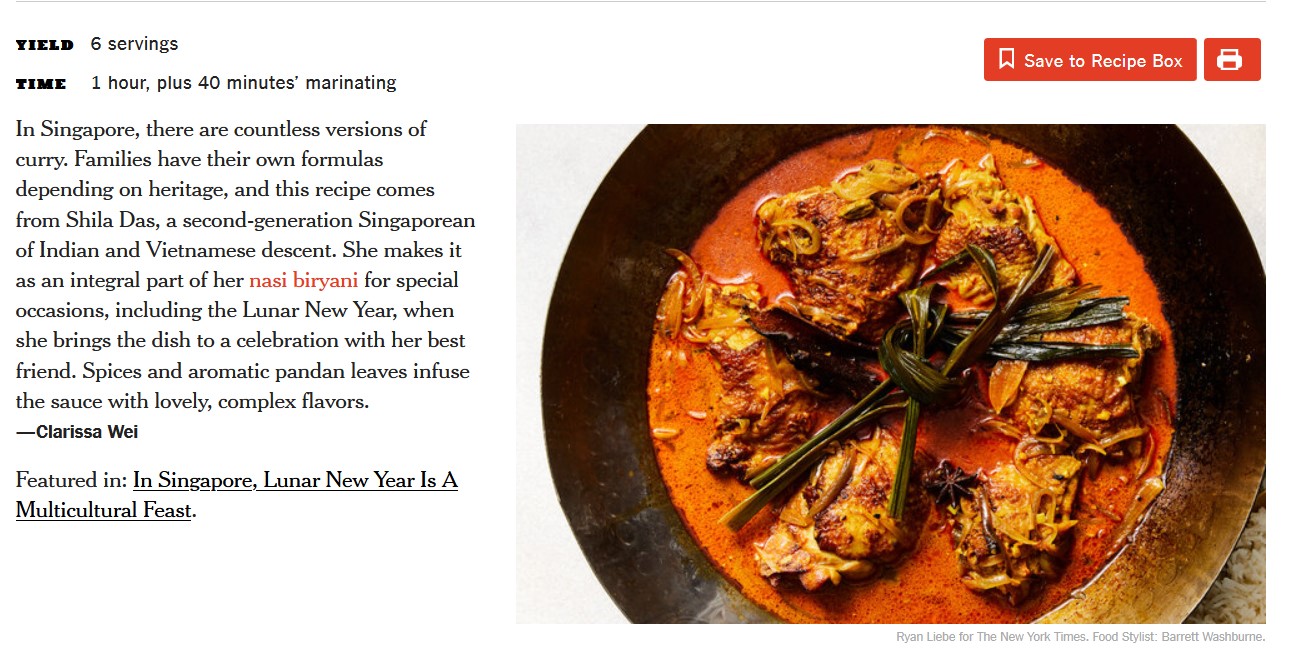One of the greatest mysteries that The New York Times has presented to Singapore this Chinese New Year is how they managed to butcher a perfectly decent Chicken Briyani recipe into a “Singaporean Chicken Curry”.

Like, how on earth did you manage a delicious-looking Chicken Briyani into chicken dunked into a marinade of unpolluted water and half-translucent spices?
In case you’re not caught up with how this abominable transformation happened, you can watch this helpful summary video below:
NYT Explains It Was a ‘Layout Issue’
The same question has troubled Ms Shila Das, the 51-year-old home cook who had given New York Times Cooking (NYT Cooking) the recipe for a feature about how multicultural Singapore celebrated the Chinese New Year.
After nearly three weeks of being told to disregard the hate mails and practically ghosted by this renowned American newspaper, they finally gave Ms Das an explanation.
Wait for the punchline….
In a 15-minute phone call with the Senior Editor of the NYT Cooking, Ms Genevieve Ko, she explained that the Chicken Briyani recipe had been split into two because of a “layout issue”.
That’s right, you heard her folks, the esteemed newspaper’s cooking site apparently can’t handle recipes that take more than 6 steps, or else it will irrevocably crash the page, cause mayhem in the IT department, and probably burn down their server rooms.

It’s funny that Ms Ko has the thick skin to say that, because a casual Google search online for longer recipes on NYT Cooking yielded a Pierogi Ruskie (Potato and Cheese Pierogi) recipe that is 12 steps long.
NYT Cooking also has a Lamb Briyani recipe that is 7 steps long, with an equally long list of ingredients for the lamb, fried onions, rice, and assembly process.
The Singaporean Chicken Curry and Nasi Briyani recipes—which are still in separate parts on their website by the way—have 4 and 6 steps respectively.
Even when combined together, it’s still two steps less than the Pierogi Ruskie recipe.
Don’t try and cover the Ms Das or the audience’s eyes with horse manure; we’re not stupid, we know how basic webpages work.
Join our Telegram channel for more entertaining and informative articles at https://t.me/goodyfeedsg or download the Goody Feed app here: https://goodyfeed.com/app/
Ms Das’ Displeased Reaction
Ms Das, the vice-president of global sales for a medical device company, didn’t believe the excuse either, of course.
Bluntly, Ms Das told Ms Ko that she was never informed that her recipe would be split into two.
“If I had known, I would have said no,” she remarked, “I also told her if the recipe had been too long, they could put another, shorter recipe on that page instead.”
NYT Cooking made the barest of amendments to the Nasi Briyani page, stating that the Chicken Curry was an “integral” part of the Nasi Briyani, despite Ms Das insisting that their supposed “Chicken Curry” recipe was never chicken curry to begin with.

Ms Dan then questioned Ms Ko who gave her the permission to split the recipe into two.
She also brought up the fact that she stressed for the video to be taken down on the day it was uploaded, and to remove any association that the “recipe” had with her, but she was only told by the paper that they would not be taking it down.
When the video was finally taken down on 11 Feb, it had already gained more than one million views and Ms Das had been at the receiving end of a torrent of hate mail that she never deserved in the first place.
After all, she had given NYT Cooking her late father’s Chicken Briyani recipe in full for the feature.
Her only fault, perhaps, was not predicting that the American paper wouldn’t follow the original recipe with faithful integrity.
“All I did was to get interviewed for a feature, but I’m the one who’s suffering. All I did was share my father’s recipe, which was slaughtered. Me being depressed is something I have to recover from on my own. They left me to die.”
Since none of her goals were met during the brief phone conversation, Ms Das intends to write to the paper formally, requesting that the recipe is published on their website as it was originally written.
However, Ms Das is not holding her breath on whether they will be taking her formal complaint seriously, especially given their lacklustre and reluctant response to her previous reasonable demands.
Truth to be told, I don’t think Ms Das has even received the proper apology that is owed to her.
Read Also:
- There’s a TikTok Channel That Has Real Videos of S’pore in the Past
- Scammer With SPF Sticker on Cap Asks, ‘Do You Know S’pore Police?’
- There’s a Wild Boar Roaming Around Bukit Panjang Like a Community Cat
Featured Image: New York Times Cooking




